40 Romanian Christmas Dishes
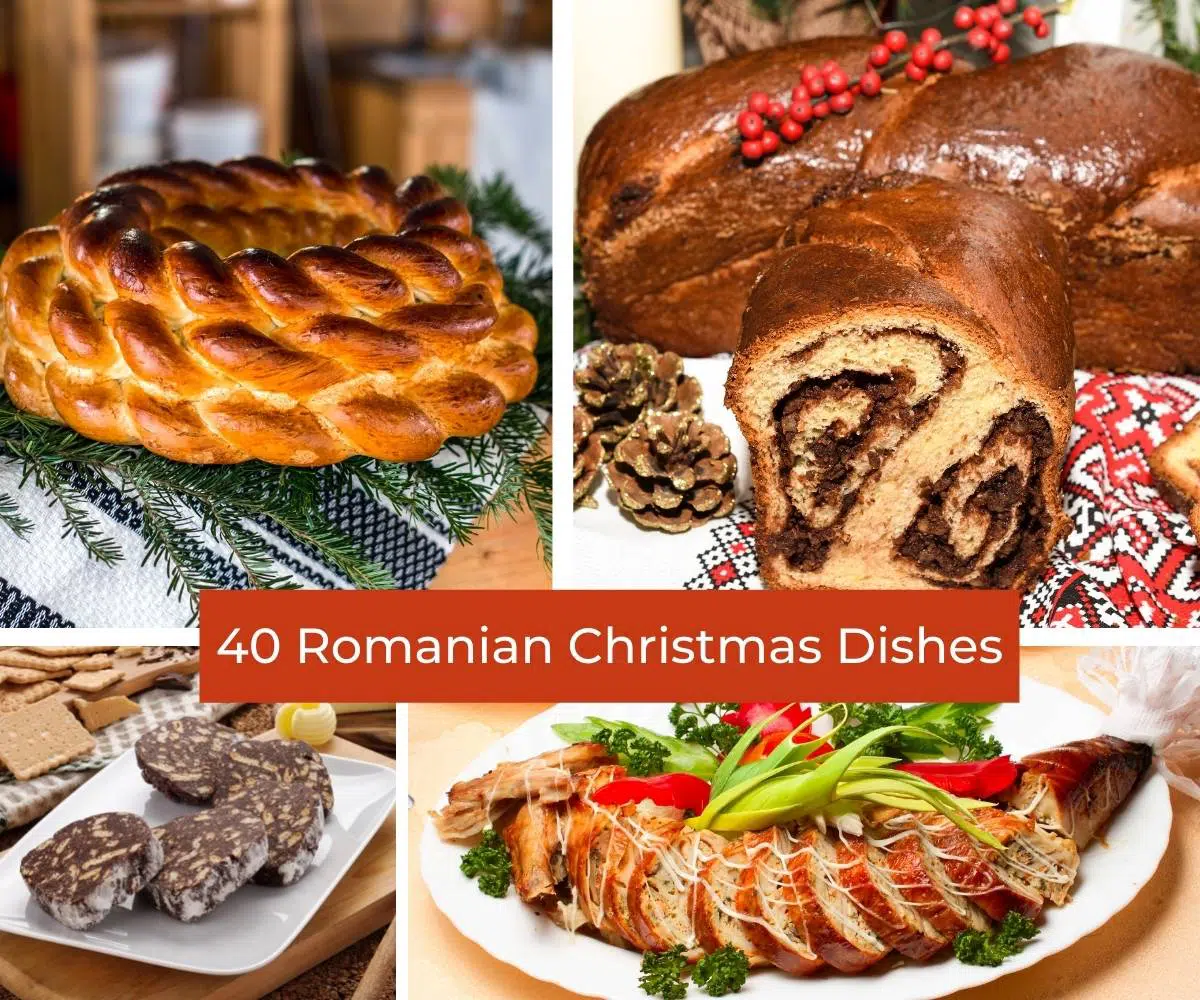
A country in Eastern Europe, Romania has a diverse geography and a rich history, both reflected in the country’s complex cuisine. With the Carpathian Mountains crossing the country through the middle and the Black Sea bordering the country in the southeast, Romania was historically divided into four territories, which became one country after World War II. These four regions (Transylvania, Moldavia, Walachia, and Dobruja), although using the same language, evolved under very different historical conditions are were differently influenced by other cultures and ethnicities.
The varied essence of Romanian gastronomy is especially obvious in the traditional Christmas dishes specific to every historical region. Christmas is one of the most important holidays in Romania, as it has a deep spiritual and cultural meaning.
Traditional Christmas cooking is a ceremony involving all the generations of a family and is usually associated with other holiday rituals. In modern times, only some of these ceremonial actions are still performed, but Christmas cooking remains a very important part of Romanian traditions.
Romanian Christmas dishes vary depending on historical regions. The main geographical regions of the country are defined by the landscape and by the country’s history. Ethnical influences in each region vary a lot, so local cuisines also vary.
Gastronomy from Transylvania is strongly influenced by Hungarian and Saxon cooking. The cuisine in Moldavia (not to be confused with Republic of Moldova) has Russian and Ukrainian influences, while gastronomy in Walachia and Dobruja is influenced by Turkish and Greek cooking.
Christmas Dishes in Dobruja
Savory dishes
Dobruja is the region of Romania that borders the Black Sea so, naturally, many dishes from this region are based on fish. Also, there is a strong Turkish influence here, as the territory was ruled by the Ottoman Empire for hundreds of years. This influence is present in the use of herbs and the traditional pies baked in this region.
Starters
40. Salată de Icre (Roe Salad)

Roe salad is a very common appetizer or snack in Romania. As the Dobruja region is famous for its fish dishes, it is the place to find the best roe salad. Of course, many stores sell the salad as a ready-made product, but the homemade version tastes better.
Romanian roe salad is usually prepared with carp, herring, or pike eggs, which are mixed with oil and a drizzle of lemon until they turn into a cream. A variation to the dish is adding chopped onions, which complement the taste of the salad perfectly. The salad is consumed on toast or with fresh bread. It is one of the most common Christmas appetizers in the Dobruja region.
39. Cherdele (Dobruja Pies – old recipe)
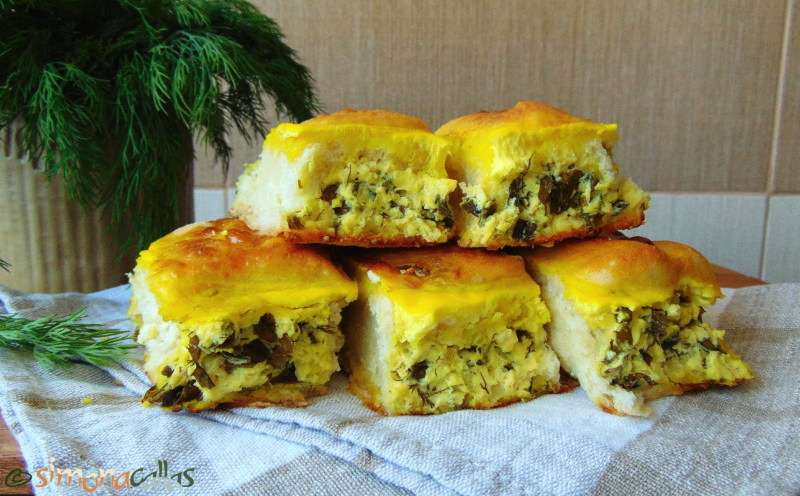
While the modern Dobruja pie recipe is influenced by Greek cuisine (because of the puff pastry, a staple in Greek cuisine), the traditional Dobruja pies are made with bread dough. This way they can be made when the Christmas homemade bread is prepared. The pies are an excellent starter for Christmas dinner or a snack, as they are savory and flavorful.
For the cherdele, the bread dough is stuffed with a mixture of salty sheep or goat cheese, eggs, fresh dill, and scallions. Then the dough is rolled, portioned into slices, and baked. Right before the cooking time ends, the pie is covered with yogurt mixed with eggs.
38. Piftie de Pește (Fish Aspic)

In Romania, aspic is a dish strongly linked to Christmas traditions. As tradition required sacrificing pigs around Christmas (there is even a religious holiday for this, on the 20th of December), many dishes that used every part of the animal became very popular. One of these is aspic, which diversified. Because in some parts of the country, such as Dobruja, pigs were rarely raised, people turned to the meat on hand, such as fish.
Fish aspic uses the same principle as any other aspic. It is a bone broth, flavored with carrots, onions, garlic, peppers, and bay leaves, to which fish meat is added after boiling. The broth is then strained and left to cool, with the fish meat and some vegetables added to it. After cooling in the fridge for a few hours, the aspic is ready.
Soups
37. Ciorbă Pescărească de Pește (Fisher’s Fish Soup)

As Dobruja has access both to the Danube and to the Black Sea, it’s natural that many traditional dishes in this area are made with fish. Also, Romanian cuisine is mostly based on soups, which are viewed as a universal starter for every meal. The Dobruja fish soup is a staple dish for fishers who use all kinds of fish and have a special way of eating the soup.
The soup is cooked in a fish broth, usually made with the small fish catch of the day. Several types of vegetables (carrots, onions, peppers, root celery, tomatoes, and potatoes) are cooked in the broth. Then the large fish is added (carp, catfish, mullet, bream, pike, or sturgeon) and cooked until soft. The soup is soured with vinegar and flavored with fresh lovage. Fishers used to add roe to the soup if they found it in the fresh fish. The meat is eaten separately from the soup, usually alongside a garlic sauce.
Main dishes
36. Saramură de Pește (Fish Tomato Stew)
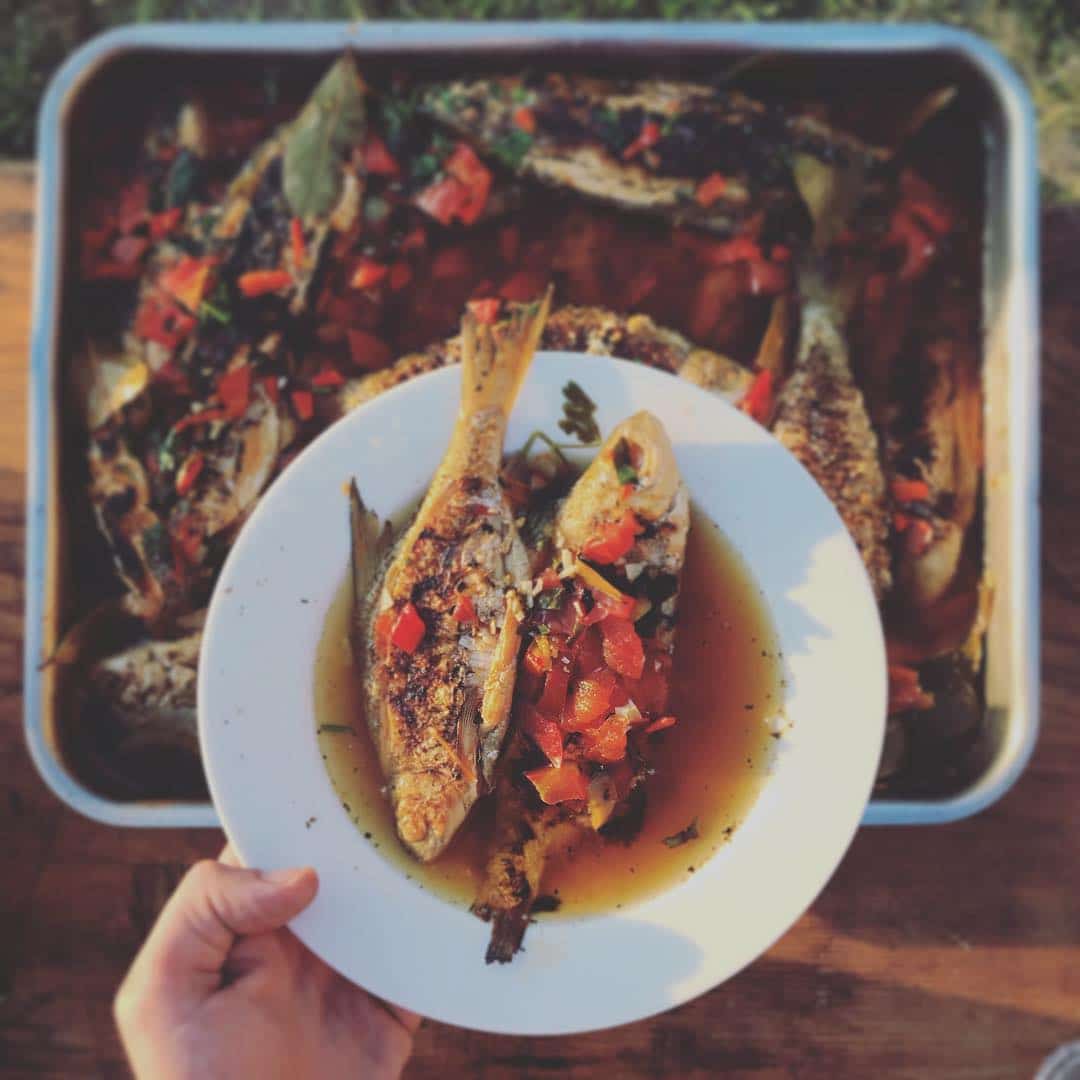
Saramura is not a stew, but a very thick sauce served with grilled fish. The fish is boiled in the sauce for a short time so that the flavors mix. The sauce is prepared with garden tomatoes, peppers, hot chilies, thyme, and garlic. For added flavor, the tomatoes, peppers, and chilies can also be grilled and then mashed together. The mixture is further boiled until it becomes a thick paste, then the grilled fish is added.
Fish prepared in this way is eaten all year round. It is easier to make this recipe in summer, as tomatoes and peppers are in season. To obtain the same flavorful sauce during winter, people prepare homemade tomato sauce and grilled peppers to be kept over winter. These can be used when making the dish during autumn or at Christmas time.
35. Știuca Umplută (Stuffed Pike)

The main dish in a Dobruja Christmas dinner, the stuffed pike, is a complex food that requires preparation and multiple stages during cooking. A traditional food of Dobruja, it uses a variety of fish with sweet-tasting, fine meat, stuffed with onions, carrots, walnuts, eggs, and fresh greens.
To prepare the dish, the pike is cleaned of its scales, and the meat is cut from the bones. Then the ground meat is mixed with the vegetables, and this mixture is stuffed inside the fish. The skin is sewn together, and the pike is cooked in the oven, together with carrots, onions, and small potatoes. 10 minutes before the dish is ready, the fish is splashed with white wine so that the flavors mix. Served with lemon wedges and oven-baked vegetables, it represents a light main dish for Christmas.
34. Sarmale de Pește (Stuffed Cabbage Rolls)

Romanian Christmas is synonymous with stuffed cabbage rolls when it comes to main dishes. Cabbage rolls are a dish common to many Balkan countries and Turkey, but in Romania, they have gained the popularity of a national dish. Prepared differently according to the historical regions, cabbage rolls are a must-try in traditional Romanian cooking.
In Dobruja, stuffed cabbage rolls are made with minced fish meat, as this is the most available type of meat. Pickled cabbage is used, as it has a sour taste that pairs perfectly (in opposition) with the sweet hint of the meat mixed with rice.
The cabbage leaves are cut, stuffed with a mixture of minced fish meat (fatty fish is preferred), onions, rice, carrots, salt, pepper, dried thyme, and greens (dill and parsley). After being rolled, the stuffed cabbage rolls are laid on cabbage leaves, in a pot, covered with tomatoes and a small thyme branch. They are cooked for approximately 2 hours and a half and served with a thick polenta.
Sweet Dobruja Christmas dishes
33. Turte de Crăciun (Dobruja Christmas Pie)

Dobruja Christmas pies are a specific local Christmas tradition. On Christmas Eve, people gift them, alongside vegetarian cabbage rolls, dried plums, and pretzels. They are also given as a gift for carolers, who visit houses on Christmas Eve. The pies are reminiscent of the Turkish influence over Dobruja province, as they resemble traditional Turkish sweets.
The pies are made with a pasta-like dough, spread and lined into thin sheets. The dough sheets are baked in the pan, using no oil. After they dry for 24 more hours, the dough sheets are soaked in a sugary syrup, made with sugar, water, and rum essence. Then, each dough sheet is sprinkled with baked walnuts, mixed with sugar and lemon rinds. The resulting pie comprises several syrup-soaked layers of dough and the walnut filling.
Traditional Christmas Foods in Moldavia
Situated in the Eastern part of Romania, Moldavia has a rich cultural heritage, which includes a varied cuisine with Russian influences and strong attention to detail.
Dominated by powerful noble families during the Middle Ages, who placed great importance on comfort and luxury, Moldavia preserves this worldview in many Christmas traditions, especially those concerning food.
Moldavia is the region that became best known for the most complex cozonac (pound cake) recipe, with over 100 eggs, for the best sarmale (cabbage rolls) recipes and folding techniques, and the best vegetarian food prepared in monasteries.
32. Alivenci (Moldavian Corn Pie)

A very popular Moldavian dish is alivenci, a type of savory pie made with cheese and cornflour. In Romanian tradition and stories, there are countless examples of eating alivenci, which were considered a special treat, only made for special occasions or holidays.
The principle when cooking these pies is to knead the dough constantly, starting with the cottage cheese, then adding egg yolks, sour cream, butter, and cornflour. The dough is kneaded until it becomes a very fine paste. This is mixed with foamed egg whites and then baked in the oven until it browns.
31. Cighir Moldovenesc (Moldavian Meat Patties)
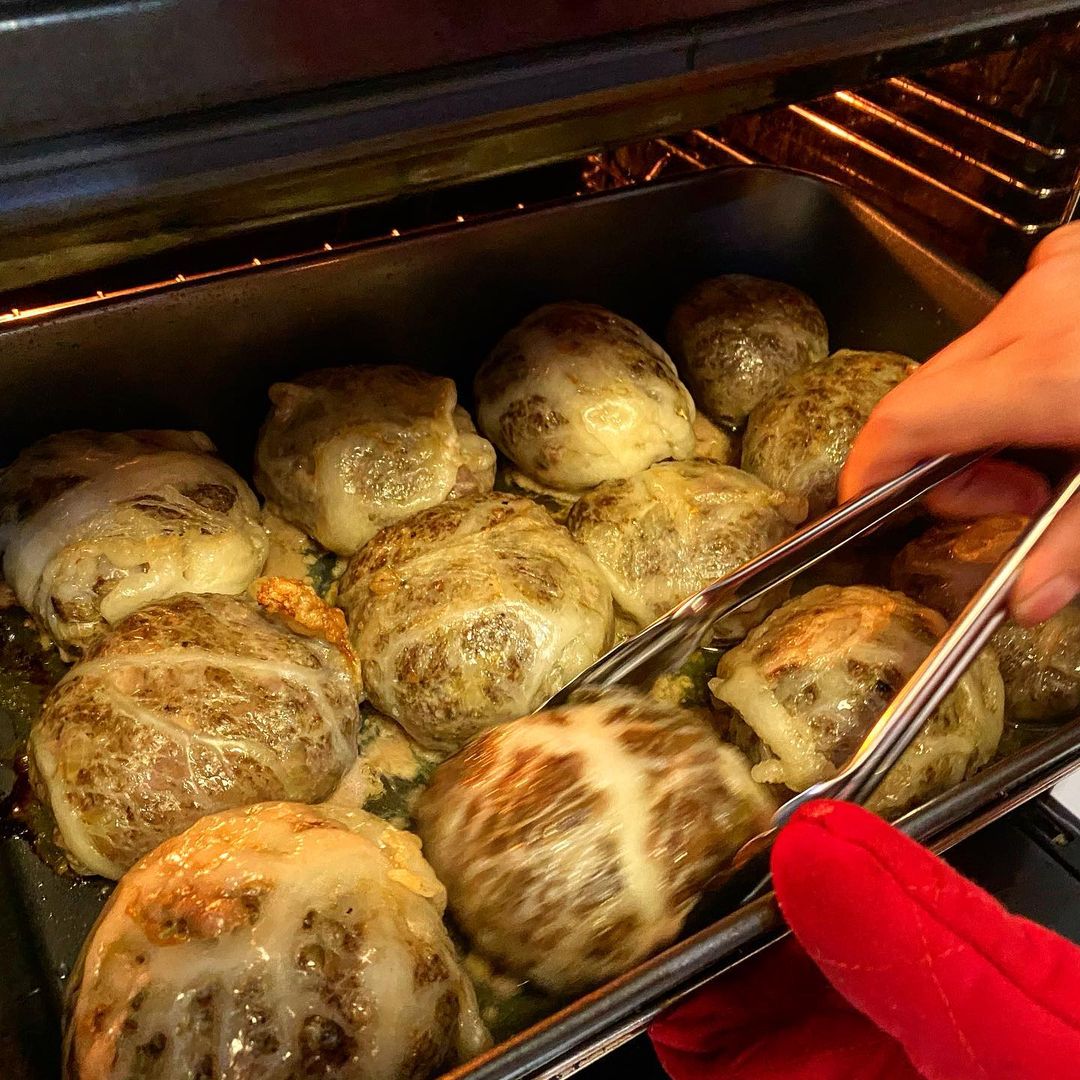
A Traditional Christmas dish, cighir is a protein-rich, fatty food, perfect for the harsh Moldavian winters, when temperatures drop well below freezing point and harsh winds blow the snow away. Similar to meat patties, cighir patties include minced pork meat, but also pork organs, and lots of flavors.
The patties are spicy and flavored with thyme, garlic, onions, bay leaves, and allspice. They are fried in lard after the minced meat is mixed with the boiled and minced organs. Traditionally, the patties were served with a generous portion of polenta and fried, homemade sausages. The meat is covered with polenta, to keep it warm. Cighir was usually spicy and salty so that it lasts longer.
30. Chișca Moldovenească (Moldavian Organ Sausage)

The harsh climate of the mountain regions of Moldavia and Transylvania and the cold winters meant that, traditionally, more fatty meat was eaten during this period. This is one reason for which many Romanian Christmas dishes are prepared with pork meat. Also, when sacrificing an animal, people used all the parts, so that nothing would go to waste. Thus, lots of Christmas starters include organs, prepared in all kinds of manners.
The organ sausage (called chișca in Moldavia or caltaboș in Transylvania) has many types of recipes (with or without tomato sauce, with rice, or with corn). Flavored with bay leaves, peppercorn, and allspice, it is served boiled, roasted, or oven-baked, together with roasted vegetables.
29. Șorici (Pork Skins)

In the spirit of sustainable use of resources (not throwing anything away), a popular food in Romania around Christmas is pork skin. Grilled, smoked, salted, or preserved in brine, it represents a protein-packed chewable snack, which you either love or hate.
In Moldavia, pork skins are preserved in brine, so that they last longer. De-greased, the skin is rolled up into strips, which are placed in a jar with garlic, bay leaves, and peppercorns. Everything is then covered in salty water. This way, pork skins can be kept in the fridge for up to 2 months.
28. Piftie Porc (Pork Aspic)

Romanian Christmas aspic is usually prepared with pork. The only exception is the Dobruja region, where fish meat is used for most types of food. The Moldavian version of the dish is made using pork feet and ears, and, of course, pork meat. Pork aspic is usually served as a Christmas dish at the start of the dinner.
To make the dish, the pork feet, ears, and meat are boiled for up to 5 hours, along with onions, carrots, and chilies. The next day, after separating the fat from the broil, the liquid is passed through a sieve, cleaned, mixed with crushed garlic, then used to cover the meat pieces. After 24 hours in the fridge, the aspic hardens and can be eaten.
27. Borș Moldovenesc (Sour Moldavian Soup)

Moldavian cooking is very particular about the methods used to cook certain dishes. Hence, a lot of importance is placed on the technique used for the sour taste of the soup. Actually, according to Moldavian cooking, soup has a sweet taste, obtained from boiling meat and vegetables, whereas ‘‘ciorba” is a soup with an added sour taste, obtained by using lemon, vinegar, or green mirabelles.
‘‘Borș” is a soup with an added sour taste, obtained by using borș, a type of sour brine made with wheat and yeast. The best borș is homemade throughout Moldavia.
The sour Moldavian soup recipe is prepared similarly to chicken soup. When the meat and vegetables are soft, tomatoes or tomato juice is added, then the borș. The soup can be as sour as preferred. This soup can also contain noodles, according to preferences. The best flavor for this recipe is fresh lovage, which is added after turning the heat off.
26. Ciorbă Rădăuțeană (Rădăuți Soup)

The Rădăuți soup is a Moldavian dish from the town of Rădăuți. It is one of the most appreciated soups in Romania, because it takes a beloved soup recipe (tripe soup) but makes it easier to digest, as it replaces tripe with chicken. The original recipe calls only for chicken breast, but other parts of the bird can be used.
The Rădăuți soup starts as a usual chicken soup. After the meat and vegetables are boiled, they are separated from the liquid; the meat is deboned and cut up into chunks, and the vegetables are sliced (apart from the onion).
The meat and vegetables are covered with the soup, to which vinegar is added. The soup is completed with cream of yolks and sour cream. Garlic and pickled red peppers are added for flavor. It is served with freshly baked bread, chilies, sour cream, and a Romanian garlic sauce called ‘‘mujdei” (or ‘‘sarmuzac”, depending on the region).
25. Tochitură Moldovenească (Moldavian Fried Meat)

The technique used to make tochitura (it means ‘‘molten” in the Moldavian dialect) means choosing a large amount of fatty fresh meat, which is cooked in molten pork fat, alongside smoked sausages and other smoked meats. The meat is cooked until brown and crisp. Tochitura is a dish cooked in all the regions of the country around Christmas, but served differently, according to the region.
The Moldavian ‘’tochitura” is traditionally cooked in a large pot, on an open fire, and flavored with garlic and thyme. It is served with hot polenta, fried eggs, and sheep’s cheese, and it goes perfectly with local Moldavian red wine.
24. Colac Moldovenesc (Moldavian Braided Bread)

The colac is a staple dish of Moldavian celebratory cooking. An ancient symbol of hospitality (it is served as a welcome symbol for visitors, alongside salt), it is an important part of any celebration in Moldavia, from weddings to religious holidays, and everyday ceremonies. There are lots of traditions connected to this dish, but one of the most important, especially at Christmas, is serving the colac as a welcome symbol to the carolers who announce Jesus’ birth.
The colac is prepared with bread dough, comprising of flour, milk, water, yeast, sugar, and oil. After the dough has risen, it is divided into parts, which are then braided together in the shape of a circle. After placing the dough in the baking tray, it is covered with a thin layer of egg yolk, which gives it a specific shine when cooking.
23. Crăciunei (Small Moldavian Braided Bread)

This is the kids’ version of the colac. Baked only at Christmas time, they are smaller than colac, sweet, and meant to symbolize hospitality for the children. Also, the Crăciunel has a slightly distinct shape, similar to the number 8.
The recipe is like the recipe for colac, but has a little more sugar and vanilla flavor, turning it into a real sweet dish. The dough is also braided, as for the colac, but it is not placed in a circular shape, but rather in an 8-shape, with the lower ends unconnected.
22. Cozonac Moldovenesc (Moldavian Pound Cake)

The cozonac is the most popular Romanian cake served around Christmas and Easter. It is similar to the Italian panettone, but comes in a rectangular shape and has no cream filling, but crushed walnuts and cocoa or poppy seeds. The Moldavian version of the cake differs from the recipes in the rest of the country because of the huge number of egg yolks (20 egg yolks to 1 kilogram of flour) and the long kneading time.
Cozonac dough has a very specific smell, which results from the combination of milk, melted butter, lemon rind, vanilla, and yeast. The recipe also calls for lard and buttermilk. The dough is kneaded for one hour, filled with crushed walnuts or poppy seeds, and then baked. After the cozonac cools down, it should be easily torn into strips. Tearing it apart was the traditional way of eating it.
21. Învârtită cu Nucă (Walnut Swirl Pie)

A sweet Christmas treat similar to the Turkish baklava, the Moldavian walnut swirl pie is made with rising dough, a walnut filling, and melted butter. The typical swirl shape is a traditional Moldavian feature that is also used for colac and, sometimes, cozonac.
The walnut swirl pie uses 500 grams of walnuts, which are chopped and mixed with sugar, orange and lemon peels, and vanilla. Then, the dough is rolled into six long tubes, filled with the walnut mixture, then laid in a circular shape into the baking dish, left to rise for 30 minutes, then baked in the oven.
Walachia
Bordered by the Carpathian Mountains in the North and the Danube in the south, Walachia is the Romanian province formerly called Țara Românească. It comprises two regions, Muntenia and Oltenia, which share both linguistic and cultural common features.
The strongest influence in the region is the Turkish one, as Walachia was part of the Ottoman Empire for hundreds of years.
20. Zabic (Corn Pie)

An ancient and versatile dish from the Gorj county region, zabic is a very simple savory small pie made from corn flour, water, and salt. Zabic is cooked and eaten throughout the year, but it is especially popular around Christmas, as it can be cooked in the fat resulting when boiling certain types of homemade sausage.
To make the pies, cornflour is mixed with water and salt, until it becomes a dough-like paste. Small pies are formed from this dough and cooked in sausage fat or the oven. The small pies can be used in soups, like croutons, or they can be served in a fatty, rich broth, made after sausages are boiled on Christmas Eve. The broth with the little pies is offered to carolers to help them stay warm.
19. Zacusca

A dish with Turkish origins, zacusca is an autumn tradition in Romania, when the smell of the cooking vegetable fills up the streets in both cities and villages. It is consumed during autumn and winter months, and it represents an important vegetable source during the harsh winter months, when, traditionally, there are no fresh vegetables available. The dish is also part of Christmas meals, as a starter, as it offers a fat-free alternative to the heavy pork dishes.
There are many ways to cook zacusca and many recipes. Most recipes use different peppers, onions, eggplants, courgettes, perhaps beans or mushrooms, tomatoes or tomato sauce, and salt and pepper. The vegetables are cooked in batches, as most cooks make large quantities.
The best recipes require for the peppers and eggplants to be grilled first, then peeled and chopped until they become a paste. Then, the onions are cooked and chopped, then the other vegetables. After this, all the vegetables are mixed in a large pot together with tomato juice, bay leaves, peppercorns, and some salt, and left to simmer. When the flavors and textures are thoroughly mixed, the paste is placed in jars and sealed for the upcoming winter months. It is consumed on toast or with loaves of fresh bread.
18. Ciorbă de Burtă (Tripe Soup)

Tripe soup is eaten all over Romania, but it isn’t a Romanian recipe. As the result of Turkish influence, tripe soup has taken a road of its own in Romanian cuisine, with added sour cream, egg yolks, fresh lovage, and vinegar. The recipe has many variations, but the area where it is most popular and considered a hospitality staple in Walachia.
Tripe soup starts as beef consomme, to which tripe, vegetables, and vinegar are added and left to boil until the liquid becomes thick. The soup is flavored with vinegar and pepper, and further thickened with egg yolks and sour cream. It is served with chilies, garlic sauce (mujdei), vinegar, and sour cream. In Romania, tripe soup is cooked both by home cooks, but also by restaurants. Most cities have one or two well-known restaurants that serve the best tripe soup in the area.
17. Borș Oltenesc de Praz (Wallachian Leek Sour Soup)

As Wallachian cooking is mainly based on vegetables, it is lighter than the dishes specific to the other parts of the country. The western part of Walachia is especially fond of leeks, a vegetable that can be found in many dishes from this area of the country. Also, Wallachian cooking has many dishes made with fresh vegetables and fruit, so it offers a great variety of foods during summer and fewer staple dishes during winter.
The leek sour soup is made with leeks, carrots, peppers, tomatoes, potatoes, and snap peas. After the vegetables are boiled and soft, the sour brine (borș) is added, together with fried bacon, and parsley for flavor.
16. Praz Umplut (Stuffed Leeks)

This is another version of the very popular cabbage rolls, in which the cabbage is replaced with leek stems. The recipe has a Moldavian origin, but it became increasingly popular in the Wallachia region, where leeks are more popular.
For the recipe, the leek stems are emptied and filled with a mixture of chopped veal, peppers, tomatoes, and chopped leeks. The stuffed leeks are then boiled in soup and wine and then cooked on an open fire until they are slightly browned. This food represents a lighter version of the stuffed cabbage rolls, as the leeks are fresh and the meat is lean, unlike the minced meat used for the stuffed cabbage rolls which combine pork and beef.
15. Alvița

Alvița is a type of dessert with deep Turkish roots. Nowadays, it is still sold in Turkey, but rarely available in Romania, as it is extremely sweet and difficult to prepare. A traditional dessert appreciated by children, the alvița was prepared for holidays, including Christmas and Lăsatul Secului, the day before a holiday feast.
The complicated recipe comprises dough filled with a cream made from egg whites, walnuts, and a large amount of sugar, mixed with honey. The resulting dessert resembles a sandwich cake, with layers of dough under and on top of the cream. This cream hardens within 3-4 days, after which the dessert can be eaten.
14. Șerbet

Another dessert of Turkish and Arabic influence, șerbet, is a type of jam, made with fruit and large amounts of sugar. It is a typical dessert in Walachia and Moldavia, and at the end of the 19th century, it was very popular to serve alongside coffee.
Nowadays, șerbet is sometimes served at the end of holiday meals, as a sweet treat. It can be made from any type of fruit, but the preferred types are apricots, sour cherries, cherries, peaches, plums, apples, pears, and grapes. It can also be made from flowers, such as roses (a special kind, with a very strong flavor) or acacia flowers.
To make the jam, the fruit must be boiled until liquefied. Then the resulting product is passed through a sieve, mixed with a lot of sugar, then boiled until thick. Flavored with lemon juice, the șerbet is kept in glass jars and usually served on special occasions.
Transylvania
Separated from the rest of the country by the Carpathian Mountains, Transylvania (or Ardeal, depending on the origin of the name) comprises several regions. In fact, during the Medieval Ages, when the territory belonged either to the Habsburg or the Austro-Hungarian Empire, there were seven regions in Transylvania.
Strongly influenced by Hungarian and Saxon language and mentalities, Transylvania is different in many respects from the rest of the country. One of these aspects is represented by culinary traditions.
13. Sângerete (Blood Sausage)

Blood sausage is a traditional Transylvanian Christmas starter. Blood sausages are common in Central and Western Europe, as cooked blood is considered a nutritious food. In Transylvania, the resulting sausage also contains meat and slănină (pork fat), and, after being boiled for several hours, it is smoked.
To make sângerete, the fresh blood from a slaughtered pig is mixed with salt and boiled slowly, until it thickens. Then, it is passed through a sieve and combined with minced boiled meat and organs. Pieces of slănină can be added to the mixture, which is flavored with allspice, pepper, and crushed garlic.
The mixture is then stuffed into cow or pig intestines (around Christmas, they can be bought in local butcher shops). Then, the sausages are sunk in hot water (not boiling). After the sausages are cold, they are smoked with cold smoke for two days, so that they are ready for the Christmas meal.
12. Slănină (Smoked Pork Fat)

A recipe of over 1000 years, slănina is similar to Italian pancetta but rougher, saltier, and with almost no meat. It is prepared from the layer of fat between the pork’s skin and meat, and results in a block of fat which can be prepared or melted and turned into lard.
The best types of slănina are made using pork belly fat, as this is softer. Slănina is so common in Transylvania that it is eaten throughout the entire year, not only at Christmas. It was part of the traditional lunch of people who worked in agriculture, alongside cold polenta and onions.
To make slănină, the fat is separated from the meat (the skin is left on the fat) and kept in a large barrel, alongside pork knuckles and ham for several weeks (up to 7). Every week, the fat and meat are rubbed with a mixture of salt, garlic, pepper, mustard seeds, and bay leaves. After 6 weeks, the fat and the meat are cleaned and left in the water to de-salt. Then they are air-dried and smoked for 4 days. In the end, they should have a golden color. Before consuming slănină, it should be left to air dry for another 2 days.
11. Tobă

Another very popular Christmas starter is toba, a combination of pork aspic and boiled sausages. It shares the key ingredients with pork aspic (pork skins, feet, ears, tongue, kidneys, heart, and pieces of meat from the knuckles or thigh). Unlike aspic, the contents of toba are stuffed inside a pork’s stomach and smoked.
To make toba, the organs, skins, and meat are all boiled together in salted water, and flavored with pepper and garlic. After boiling, the meat is de-boned, and the organs are cleaned of the skins. Then, all the meat is cut into small pieces. The water is flavored again with salt, pepper, garlic, and sweet paprika, and boiled until it thickens. The meat and flavored water are mixed and stuffed inside a pork’s stomach. Then everything is broiled for another 2 hours in the oven, at 80 Celsius degrees. The next day, after is it cold, the toba is smoked for 2-3 days.
10. Cârnați (Sausages)
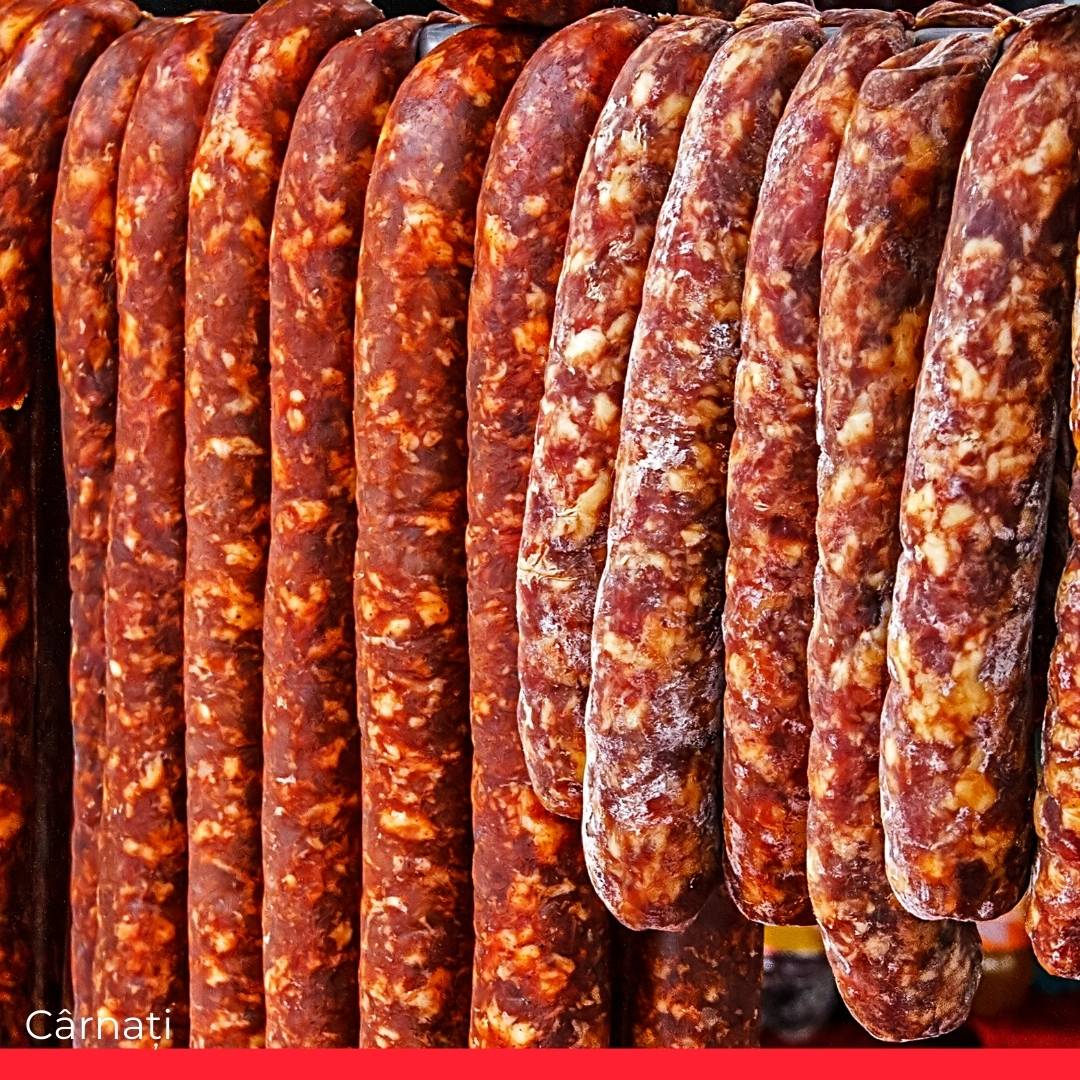
The Transylvanian sausage recipe is made with fatty meat and flavored with garlic. Transylvanian sausages have a typical taste and texture, easily recognizable for anyone who has ever tried them. The usual meat to fat ratio is 80 percent meat to 20 percent fat so that the sausages are not dry or too fatty. Also, the meat should not be minced too fine, because Transylvanian sausages are characterized by larger chunks of meat.
The Transylvanian sausages are made only with pork meat. Apart from the garlic, families have their specific combination of flavors, specific to the recipes passed down from generation to generation. Most families use paprika, cumin, and pepper.
There are several ways to eat sausages. They can be smoked and dried, fried, or boiled in sour cabbage brine. The latter preparation method is typical of Christmas time.
9. Brânză de Burduf (Matured Sheep’s Cheese)

One of the oldest traditional occupations in the mountain regions of Transylvania is sheep herding. Shepherds, or ‘‘ciobani” as they are called in Romanian, have many secrets for preparing all kinds of cheese types. The most spectacular and flavorful are the matured cheese types.
One type of matured sheep’s cheese is ‘‘brânza de burduf.” This is made from strained cottage cheese, which is then minced and mixed with salt. This mixture is introduced into a sheep’s stomach (in some variations, it is wrapped in fir tree bark) and left to mature for 2-3 months. The longer it is left to mature, the stronger will be the taste and the drier the cheese. It is eaten plain, but also in combination with polenta, in another shepherd traditional recipe, ‘‘bulz” (a ball of polenta, filled with brânza de burduf and grilled until the cheese melts).
8. Varză Murată (Sauerkraut)

If Moldavian households prefer using borș to make their soups sour, Transylvanian cooking uses mostly sauerkraut brine. Also, traditional sarmale are made with sauerkraut in Transylvania, whereas in Moldavia or Walachia the meat is wrapped in vine leaves. Sauerkraut is a Saxon influence in Transylvanian cooking, and it is so important that all fall markets are full of cabbage heads, which people buy to make Sauerkraut over the winter.
Sauerkraut is traditionally made in large barrels, and every family has its particular spice combination to flavor the brine. Some spices used for the brine are thyme and basil, but this can vary, according to the family.
The cabbage leaves should be firm, and the taste should not be too salty or too sour for the cabbage rolls to come out perfectly. The brine is also used as a hangover remedy or drank alongside baked potatoes. It can also be used for boiling sausages of pork knuckles, which become wonderful Christmas dinner starters.
Soups
7. Ciorbă de Perișoare (Meat Dumpling Sour Soup)

The traditional Transylvanian holiday soup, ciorba de perișoare, is mostly served during winter, at Christmas, or on New Year’s Eve (Romanian winter holidays usually mean a lot of food). It is a sour soup flavored with sauerkraut brine and lovage, made with lots of vegetables and meat dumplings.
The recipe starts with preparing the meat dumplings, which comprise minced pork or veal meat, onions, rice, egg, and greens. The vegetables (carrots, onions, peppers) are chopped, sauteed in oil, then boiled in stock, to which the dumplings are then added and boiled. This soup is flavored with sauerkraut brine and thickened with a mixture of double cream and egg yolks.
6. Turta Dulce (Gingerbread)

The traditional Saxon gingerbread recipe is a well-kept secret in Transylvanian families. A typical Saxon Christmas dessert, gingerbread can be found in most German and Austrian towns, with different recipes according to the region. However, in Transylvania, the best gingerbread is the homemade kind, with the gingerbread house being the most beautiful and intricate design.
The secret of Saxon gingerbread lies in the spice, and the nuts used to make the batter. The amount of each spice and the option of using or not using nuts (chopped walnuts or almonds are the most popular options) is a feature of the recipe passed down from one generation to another. Among the most popular spices used for gingerbread are allspice, cinnamon, cardamom, star anise, ginger, and white pepper.
The dough is tricky to make, as it is mostly sweetened with honey and therefore it is very sticky and hard to work with. There are certain steps in preparing the gingerbread house, and it usually takes up to one week for a gingerbread house to be prepared, baked, and glued together with royal icing. However, the result is spectacular and captures the Christmas preparation spirit.
5. Hencleș | Lichiu

The traditional Saxon wedding cake in Medieval Transylvania, hencleș is a dessert that combines cozonac dough and a pudding-like cream, made with lots of eggs and double cream. It is an expensive dessert which was traditionally prepared only for very important events (such as weddings). Saxon communities in Transylvania used to cook together, so this cake was made for lots of people, by lots of people.
The dough is prepared similar to the cozonac dough, but with fewer flavors and in smaller quantities. Then, the dough is pressed into a baking pan and covered with cream made from egg yolks, double cream, sugar, butter, and vanilla flavor.
During baking, the cream thickens and becomes similar to a pudding. Nowadays, hencleș has many variations, depending on the region, but all the recipes agree on the fact that the cake should have a buttery, sweet taste and a flaky dough texture.
4. Baigli (Hungarian Nut & Poppy Seed Roll)
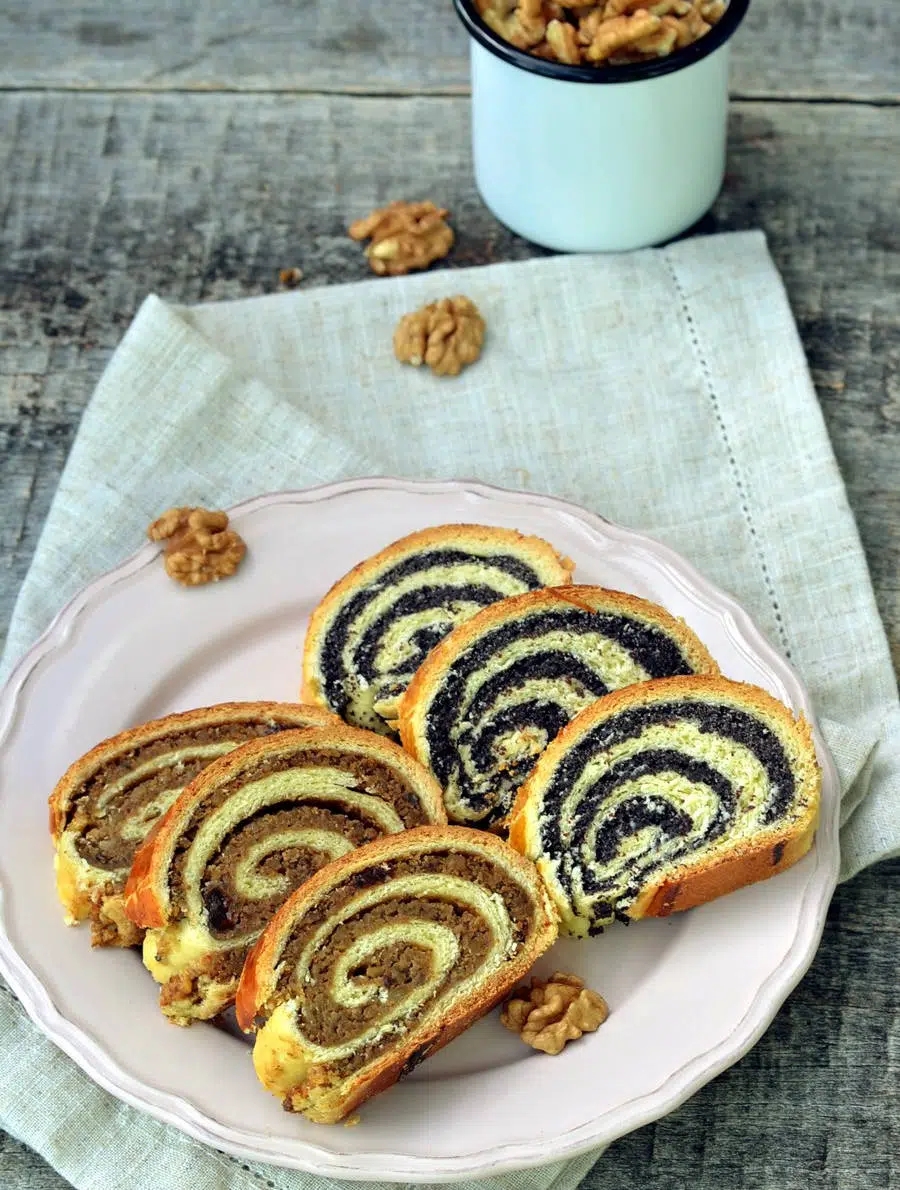
This cake of Hungarian origin is made using a dough similar to cozonac, but with a smaller amount of yeast, so it won’t puff up as much, and with fewer eggs. Also, the dough is kept in the fridge so that it won’t rise. The dough in baigli won’t be as fluffy as that of cozonac, but flakier. This results from mixing two types of fat (butter and lard), whereas for cozonac only butter is used.
The baigli filling is very similar to that used for cozonac. As the dough is not as puffy, the filling is as thick as the dough. Walnut or poppyseed cream is used to fill the dough, which is then rolled into long cakes that are baked until they become golden brown. As baigli uses a smaller amount of yeast, it is easier to digest.
3. Salam de Biscuiți (Cookie Salami)

A very popular dessert during the communist regime, this roll is made using actual cookies (the digestive biscuits kind) and a simple filling with cocoa, orange and lemon rinds, dried cranberries, dried raisins, and walnuts. These ingredients are combined with milk or sugar syrup, then mixed with the crushed cookies and butter, and rolled into a cake which is kept in the fridge until it hardens.
When cut into slices, the cake resembles salami, hence the name. It can be flavored with vanilla or rum, depending on taste. For many Romanians, the rich flavor of the cake is a beautiful reminder of their childhood, because it was such a popular cake in the past.
2. Damenkapritzen (Lady’s Pleasure)

This is a very old Saxon cake, popular at the beginning of the 20th century in the Western region of Transylvania, called Banat. Nowadays, it is considered as being one of the most representative desserts in the region, with different villages offering different variations of the same recipe.
The cake has a layer of dough made with flour, butter, sour cream, and eggs. After baking the dough, it is covered with a layer of sour jam, for example, rosehip jam (another Transylvanian specialty). The jam is then covered with a layer of meringue and chopped walnuts and then baked again until the meringue hardens. The combination of the sweet and sour jam, the sweet and fluffy meringue, and the earthy flavor of baked walnuts are mesmerizing. This cake is served cut up in small, rectangular pieces, which are eaten similar to cookies.
1. Prăjituri cu Foi (Layered Cakes)

In the central region of Romania, if you say cake, most people will think of a special product, which is the star of any festive meal. These cakes are homemade or ready to buy in some local, specific dessert shops. The recipes are actually very complicated, multi-layered cakes, with at least two sheets of sponge cake filled with one or two types of buttercream.
The sponge cake is flavored with vanilla, cocoa, or filled with walnuts. Some cakes feature two layers of sponge cake and a sheet of meringue-based cake, filled with alternating types of cream. These are all cut into small rectangles, some higher and some lower, depending on the number of layers they have. Then they are all placed on a single plate, offering a bite-sized explosion of flavors and textures.
Among the most popular are the toffee cream with walnuts cake in 5 layers (it has two layers of sponge cake and two layers of vanilla buttercream, which are repeated twice and a middle layer of toffee cream), the egg and coffee cream cake in 6 layers (with a walnut sponge cake base), the lemon buttercream cake in 10 layers, which features incredibly thin layers of sponge cake (5 sheets of cake, buttered with 5 layers of cream), and the egg buttercream cake in 5 layers, which actually has two different sponge cake layers, one with poppy seeds, the other without, and the second type of buttercream flavored with vanilla.
Christmas is a very important time in Romanian culinary tradition because it recaptures all the specific influences of the various geographical regions. It is also a time of reconnecting to traditions and family. A Romanian Christmas meal is always a wonderful occasion to understand the local culture.
Related: Traditional Romanian Desserts

Related: Popular Romanian Cookies


